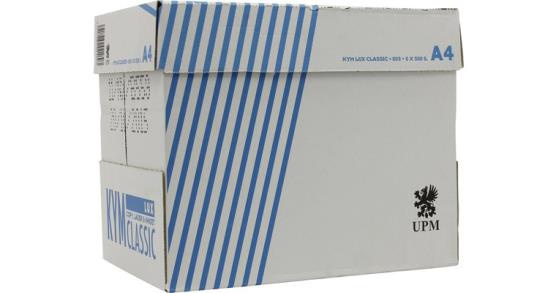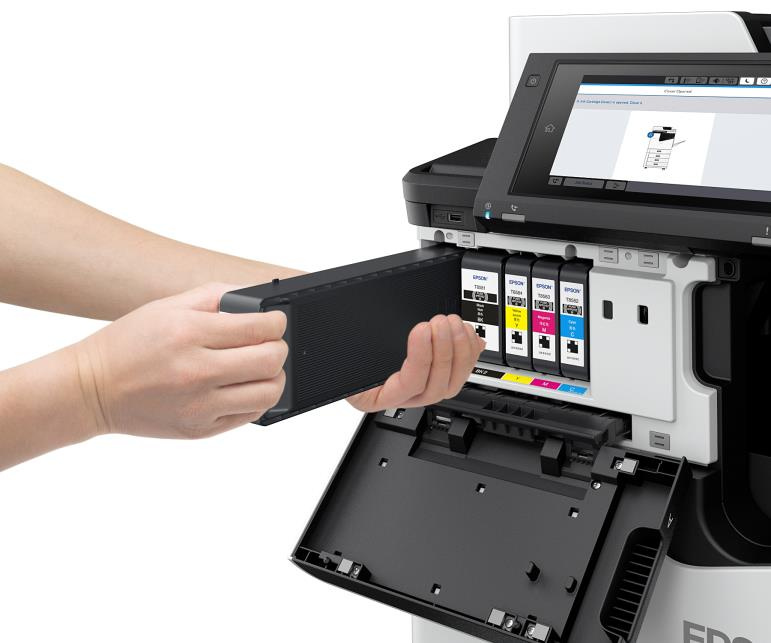Level 80 printer. Epson WorkForce Enterprise

We have repeatedly told about the Epson Printing Factory with CISS and the inkjet printers for the WorkForce Pro RIPS series business. It's time to talk about the new product - our flagship MFP with print speeds of up to 100 pages per minute . Yes, color. And yes, based on PrecisionCore Line Head inkjet printing technology.
Line head - a new tool in the arsenal of Epson. This is a stationary linear print head . It was thanks to her that she was able to achieve impressive speed and reliability: with this device, Epson discovers a new segment of high-speed devices designed for extremely high loads: you can easily print 400,000 pages with lightning speed per month on the new product.
Just for reference: here is the maximum load recommended for devices from other lines:
- beskartridnaya "Printing Factory" - about 3000 pages per month,
- WorkForce Pro printers and MFPs - up to 10,000 pages per month,
- powerful WorkForce Pro RIPS series printers and MFPs with ink containers designed for printing up to 75,000 pages - maximum monthly load up to 65,000 pages.
In this post, without further ado, we briefly describe the main "features" of the device and define the scope of its application.
Linear print head. +100 to speed, +200 to stamina
The print head is a key component of any inkjet printer. Linear print head is a true piece of engineering art.
Let us recall how inkjet printing technology is traditionally described: ink droplets are injected through microscopic holes (nozzles), the rows of which are located on the carriage moving along the paper .

It is logical that the speed of movement of this carriage determines the speed of printing the printer. Unfortunately, life is full of compromises, so the endless increase in the speed of movement of the print head in the printer irrepressibly reduces its reliability to nothing due to the rapid deterioration of the entire structure when printing at unnecessarily high speeds.
But the linear print head does not move . This is a stationary printer element the size of the entire width of the sheet. In particular, in the line of Epson Enterprise devices, the print head is equal in width to an A4 sheet.

Therefore, printing speed is limited not so much by the ink transfer system on paper, but by the general design of paper intake and feeding. And at the moment Epson engineers managed to achieve print speeds of up to 100 pages per minute in standard quality (not in draft!)
And it looks like this:
Or so (more detailed video):
Thus, if, for example, you start printing “The Lord of the Rings” on Epson WorkForce Enterprise, then it will take only 12 minutes to print 1187 pages in A4 format with the 12th Arial font!

Print Resolution Bonus
What do they mean when they talk about high-quality graphics? Of course - the elaboration of small parts and clarity of the picture. The print head and high-quality fine ink again are responsible for detailing the print. The Enterprise printhead has 33,500 nozzles, of which ink is produced every second under the strict control of electronics. The maximum print resolution of Epson WorkForce Enterprise is 600 × 2400 dpi. Therefore, if you undertake to print "The Lord of the Rings" with pictures, then the quality of these pictures will be at their best.

With a first aid kit at the ready. Nozzle Verification System
Sooner or later the question will arise: what to do if one of the nozzles clogs during printing? In modern printers, this happens very rarely, but still it is impossible to rely on "maybe". Epson has a solution. For industrial labeling machines, Epson has long been using Nozzle Verification technology. It was also adapted for business devices. Nozzle Verification automatically detects a clogged nozzle and compensates for a point without stopping printing due to the fact that nozzles in the print head are located diagonally. The result - no spoiled sheet in the printing process. Of course, the clogged nozzle, after printing, is cleaned once or twice through the driver.
Breathe deeply and type
It's no secret that fine toner dust from laser printers hovers in the air and settles in the lungs. With liquid ink this does not happen. That is why inkjet printers are a much more environmentally friendly solution than laser ones. According to research, WorkForce Enterprise complies with ISO standard Level 5 for clean rooms.
A clean room is a complex technical structure in which the concentration of dust particles suspended in the air is regulated and a specific microclimate is maintained.
According to the ISO standard, level 5 is assigned to aseptic productions of injection preparations, which require the absence of microorganisms and particles, as well as rooms for carrying out surgical operations on the implantation and transplantation of organs. Isolation of patients with immune deficiency, including after bone marrow transplantation. About any installation of a laser in such conditions is out of the question.
Addons and upgrades. Options

A printer of such a high level should have adequate equipment.
Paper feed unit is an optional paper loading tray. Its capacity is 3000 sheets. You can load A4 paper with a density of up to 160 g / m 2 .
In the basic configuration of Epson WorkForce Enterprise, the resource of trays is 2350 sheets: 4 trays of 550 sheets each (including A3 format) and a manual feed tray with a resource of up to 150 sheets. So with the optional tray capacity is already increased to 5350 sheets . These are four and a half of Tolkien’s books printed by us.
To the left of the device are the finishing options: a sorter and a document stepper.
The sorter consists of two trays. Capacity of the sorter and the stapler - 4000 sheets. That is, as much as possible it is possible to send the job and up to 4,000 sheets for printing and subsequent automatic binding.
The center is the connecting module for the finisher.
Since the printing speed is very high, the prints from the device come out slightly wet. In order for them to dry before getting into the sorting trays or stapling trays, you need this connection module. There are no heating elements. As the paper passes through the connection module, the prints dry out. Just a couple of seconds and the imprint is completely ready.
Heroic Stamina. 400,000 pages per month
Epson WorkForce Enterprise is not the only linear inkjet printer on the market. But the only one that can withstand a load of 400,000 pages per month.
These are 800 packs of 500-sheet paper, that is, 160 of such office paper packages :

Expenses full inventory
It is absolutely obvious that the more powerful (and faster) the machine is, the more resources it needs for its operation. In our case, we are certainly talking about ink. What volume should be cartridges for such a device?
Cartridges in Epson Enterprise devices are designed to print up to 100,000 pages. One kit includes two black, magenta, yellow and cyan cartridges.
That is, 84 volumes of the “Lord of the Rings” can be printed from the ink set. Seems not bad. And pigment ink also does not spread on paper, which allows to fully appreciate the high resolution that the device can produce when printing.

"Inkjet" come
Historically, the offices still reign laser printing. However, the world's leading experts have already noted a marked increase in the number of inkjet devices for business. Analysts from Gartner write that in 2016 the share of inkjet printers accounted for less than 8% of the total office printing. However, inkjet technology is evolving very quickly in terms of print quality and speed, and on average, the cost of ownership of an inkjet printer is much cheaper, both in terms of energy consumption and taking into account the cost of consumables, especially considering the recent trends in the transition to a more capacious "cartridge belt". By 2020, according to the forecast of the same Gartner, the share of inkjet printing in the office will grow to 15% already. Wait and see.
Feedback time!
Traditionally, we ask you to share your thoughts about whether, in your opinion, inkjet office printing in Russia has a future? How important is now in the offices, in particular, environmental printing?
We will be glad to your questions and comments.
All Articles